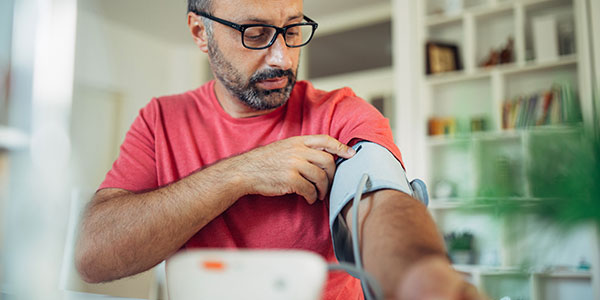Monitoring Your Blood Pressure at Home
You can’t feel high blood pressure. Known as “the silent killer,” it can have devastating effects in your body but is undetectable without using a blood pressure measuring device.
High blood pressure affects nearly half of adults in the United States and is a major risk factor for heart attack, heart failure, stroke and kidney disease.

Why Your Blood Pressure Matters
The first step in detecting and controlling high blood pressure is to have it checked by a health professional during a physical exam.
Blood pressure categories defined by the American Heart Association are:
| Blood Pressure Category | Systolic mm Hg (upper number) | and/or | Diastolic mm Hg |
|---|---|---|---|
| Normal | Less than 120 | and | Less than 80 |
| Elevated | 120-129 | and | Less than 80 |
| High Blood Pressure (Hypertension) Stage 1 | 130-139 | or | 80-89 |
| High Blood Pressure (Hypertension) Stage 2 | 140 or higher | or | 90 or higher |
| Hypertensive Crisis (consult your doctor immediately) | Higher than 180 | and/or | Higher than 120 |
If you’ve already been diagnosed with high blood pressure or have had a stroke, heart failure or kidney disease, maintaining strict control of your blood pressure (BP) can be lifesaving, so it’s wise to routinely keep track of it yourself at home. Plus, if getting anxious in a doctor’s office makes your BP go up (called “white coat hypertension”), measuring blood pressure in a calm, relaxing environment at home can provide a more accurate reading.
Blood pressure machines in public places, such as drugstores, are convenient but may not be totally accurate. If you use a public BP machine and receive a high result (over 120/80), be sure to see your doctor to have this reading verified.
Self-Measured Blood Pressure Monitoring
Self-measured blood pressure monitoring, recommended by the American Heart Association, helps you and your doctor keep better track of your blood pressure and gives you an active role in the process. Here’s how to do it:
- Buy a monitor with an arm cuff. Don’t buy a monitor with a wrist or finger cuff, which are not as accurate. Before you buy, use a string or measuring tape to measure around the circumference of your upper arm, halfway between your elbow and shoulder, to be sure the cuff will fit.
- Make sure your monitor works correctly. When choosing a BP monitor, be sure it’s been validated for accuracy and reliability. Bring it in to your healthcare team when you first buy it and then once a year afterward. In addition, bring your monitor to get checked if your home measurements are regularly 10 mmHg different (higher or lower) than those at your healthcare visits.
- Be consistent. Measure BP at least three times per week unless otherwise directed, and measure at the same place and time. Good times to measure are in the morning before taking medications and in the evening before dinner.
- Know your goal. Talk to your healthcare team about what your BP goal should be. A common goal is a systolic blood pressure (top number) lower than 140 and a diastolic (bottom number) lower than 90. In some cases, your provider may set your target BP to be lower than that.
- Keep a log. Track your blood pressure with the date, time, reading and notes. Share your log with your healthcare team at all regular visits.
- Look for patterns. If your measurements go up and down, try to understand why. Was there anything different about your day? Your BP can be affected by many things, such as changes in your medication, salt in your food, caffeine, alcohol, physical activity and stress.
How To Monitor Blood Pressure Correctly
Follow these steps to correctly measure your blood pressure. If you have questions, contact your healthcare team.
- Don’t drink caffeine (such as coffee), exercise or smoke for at least 30 minutes before taking your blood pressure.
- Use the restroom and empty your bladder before sitting down.
- Sit comfortably with both feet flat on the floor for five minutes before taking your blood pressure. Sit with your back straight and supported (on a dining chair, for example, instead of a sofa).
- Rest your arm on a table so the blood pressure cuff is about the same height as your heart (the middle of your chest). Unless otherwise directed, you may use either arm, but use the same arm each time.
- Wrap the cuff around your bare upper arm (not over clothing). Place the bottom of the cuff directly above the bend of the elbow.
- Don’t talk or do other activities while measuring your blood pressure.
- Follow the instructions for your monitor to take two to three readings at least one minute apart.
- In your log, write down all your measurements, including the date, time of day and comments about daily activity, food and emotions.
Be sure to see your healthcare provider if you’re consistently having high blood pressure readings at home.
Helpful Resources
Discover Similar Stories
Choose a topic below to read more stories like this one.




